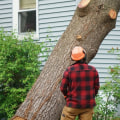Winter is the optimal time for logging for many reasons. The colder climate allows logs to be transported more easily to the banks of the river with ice roads, rather than dragging them through dirt, mud and weeds. Additionally, winter provides a workforce of lumberjacks who often cultivate in spring and summer. Trees are also cut down for aesthetic reasons or lack of light, but only with the permission of the authorities. The main reason for the fall of leaves on most trees is that, when winter comes, it is quite cold and dry in our part of the world.
To conserve resources, trees lose their leaves instead of spending energy to protect them. Maples, birches, willows, oaks, walnuts, dogwood and redbud are deciduous trees known to lose their leaves during the winter. The process of interruption of chlorophyll production results in exposure of leaf color. To make this happen, branches of the tree begin to produce abscission cells which cut these organs from the dead plant (the leaves) and heal the section where the stem and branch join. As trees conserve their energy in winter, they have more energy available to direct towards healing these wounds. Tree Conservation Orders prevent the deliberate logging, cutting, cutting or destruction of trees without the specific consent of the Planning Authority.
There is no real consensus in the tree research community as to why some tree species retain their leaves, but there are several theories. Abnormal weather patterns during late fall and early winter can cause trees to adapt and drown. This layer stops the transport of nutrients and water to the leaf and becomes the main physical reason why trees lose their leaves. Ultimately, marcescent trees lose their leaves in spring as new parts of the plant push old leaves off the branches. With few exceptions, most cities and counties require you to obtain a permit to remove a tree on your own property. In fact, some important pruning work should only be done during the winter, such as pruning fruit trees to maximize fruit production.
If you have a Viburnum on your property, knowing the characteristics, threats and life cycle of the Viburnum leaf beetle can help protect your tree from infection. Once trees detect a reduction in the amount of daylight, they begin to reduce the amount of chlorophyll they produce. Trees should be pruned at least once a year, and there are three reasons why winter is the best time to prune.



